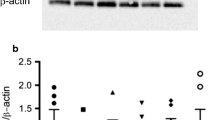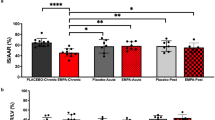Abstract
The goal of the present study was to evaluate the effects of SGLT2i on cardiac contractile function, substrate utilization, and efficiency before and during regional myocardial ischemia/reperfusion injury in normal, metabolically healthy swine. Lean swine received placebo or canagliflozin (300 mg PO) 24 h prior to and the morning of an invasive physiologic study protocol. Hemodynamic and cardiac function measurements were obtained at baseline, during a 30-min complete occlusion of the circumflex coronary artery, and during a 2-h reperfusion period. Blood pressure, heart rate, coronary flow, and myocardial oxygen consumption were unaffected by canagliflozin treatment. Ventricular volumes remained unchanged in controls throughout the protocol. At the onset of ischemia, canagliflozin produced acute large increases in left ventricular end-diastolic and systolic volumes which returned to baseline with reperfusion. Canagliflozin-mediated increases in end-diastolic volume were directly associated with increases in stroke volume and stroke work relative to controls during ischemia. Canagliflozin also increased cardiac work efficiency during ischemia relative to control swine. No differences in myocardial uptake of glucose, lactate, free fatty acids or ketones, were noted between treatment groups at any time. In separate experiments using a longer 60 min coronary occlusion followed by 2 h of reperfusion, canagliflozin increased end-diastolic volume and stroke volume and significantly diminished myocardial infarct size relative to control swine. These data demonstrate that SGLT2i with canagliflozin preserves cardiac contractile function and efficiency during regional myocardial ischemia and provides ischemia protection independent of alterations in myocardial substrate utilization.







Similar content being viewed by others
References
Al Jobori H, Daniele G, Adams J, Cersosimo E, Triplitt C, DeFronzo RA, Abdul-Ghani M (2017) Determinants of the increase in ketone concentration during SGLT2 inhibition in NGT, IFG and T2DM patients. Diabetes Obes Metab 19:809–813. https://doi.org/10.1111/dom.12881
Amende I, Bentivegna L, Morgan JP (1992) Ventricular function and calcium handling during ischemia. J Cardiovasc Pharmacol 20(Suppl 5):S42. https://doi.org/10.1097/00005344-199206205-00007
Andreadou I, Efentakis P, Balafas E, Togliatto G, Davos CH, Varela A, Dimitriou CA, Nikolaou PE, Maratou E, Lambadiari V, Ikonomidis I, Kostomitsopoulos N, Brizzi MF, Dimitriadis G, Iliodromitis EK (2017) Empagliflozin limits myocardial infarction in vivo and cell death in vitro: role of STAT3, mitochondria, and redox aspects. Front Physiol 8:1077. https://doi.org/10.3389/fphys.2017.01077
Baartscheer A, Schumacher CA, Wust RC, Fiolet JW, Stienen GJ, Coronel R, Zuurbier CJ (2017) Empagliflozin decreases myocardial cytoplasmic Na(+) through inhibition of the cardiac Na(+)/H(+) exchanger in rats and rabbits. Diabetologia 60:568–573. https://doi.org/10.1007/s00125-016-4134-x
Bayeva M, Gheorghiade M, Ardehali H (2013) Mitochondria as a therapeutic target in heart failure. J Am Coll Cardiol 61:599–610. https://doi.org/10.1016/j.jacc.2012.08.1021
Byrne NJ, Parajuli N, Levasseur JL, Boisvenue J, Beker DL, Masson G, Fedak PWM, Verma S, Dyck JRB (2017) Empagliflozin prevents worsening of cardiac function in an experimental model of pressure overload-induced heart failure. JACC Basic Transl Sci 2:347–354. https://doi.org/10.1016/j.jacbts.2017.07.003
Chen J, Williams S, Ho S, Loraine H, Hagan D, Whaley JM, Feder JN (2010) Quantitative PCR tissue expression profiling of the human SGLT2 gene and related family members. Diabetes Ther 1:57–92. https://doi.org/10.1007/s13300-010-0006-4
Cherney DZ, Perkins BA, Soleymanlou N, Har R, Fagan N, Johansen OE, Woerle HJ, von Eynatten M, Broedl UC (2014) The effect of empagliflozin on arterial stiffness and heart rate variability in subjects with uncomplicated type 1 diabetes mellitus. Cardiovasc Diabetol 13:28. https://doi.org/10.1186/1475-2840-13-28
Chilton R, Tikkanen I, Cannon CP, Crowe S, Woerle HJ, Broedl UC, Johansen OE (2015) Effects of empagliflozin on blood pressure and markers of arterial stiffness and vascular resistance in patients with type 2 diabetes. Diabetes Obes Metab 17:1180–1193. https://doi.org/10.1111/dom.12572
Chow MS (1993) Assessing the treatment of congestive heart failure: diuretics, vasodilators, and angiotensin-converting enzyme inhibitors. Pharmacotherapy 13:82S–87S
Devineni D, Curtin CR, Polidori D, Gutierrez MJ, Murphy J, Rusch S, Rothenberg PL (2013) Pharmacokinetics and pharmacodynamics of canagliflozin, a sodium glucose co-transporter 2 inhibitor, in subjects with type 2 diabetes mellitus. J Clin Pharmacol 53:601–610. https://doi.org/10.1002/jcph.88
Devineni D, Polidori D (2015) Clinical pharmacokinetic, pharmacodynamic, and drug-drug interaction profile of canagliflozin, a sodium–glucose co-transporter 2 inhibitor. Clin Pharmacokinet 54:1027–1041. https://doi.org/10.1007/s40262-015-0285-z
Feigl EO, Neat GW, Huang AH (1990) Interrelations between coronary artery pressure, myocardial metabolism and coronary blood flow. J Mol Cell Cardiol 22:375–390
Ferrannini E, Mark M, Mayoux E (2016) CV protection in the EMPA-REG OUTCOME trial: a "Thrifty Substrate" hypothesis. Diabetes Care 39:1108–1114. https://doi.org/10.2337/dc16-0330
Ferrannini E, Muscelli E, Frascerra S, Baldi S, Mari A, Heise T, Broedl UC, Woerle HJ (2014) Metabolic response to sodium–glucose cotransporter 2 inhibition in type 2 diabetic patients. J Clin Investig 124:499–508. https://doi.org/10.1172/JCI72227
Fillmore N, Lopaschuk GD (2014) Malonyl CoA: a promising target for the treatment of cardiac disease. IUBMB Life 66:139–146. https://doi.org/10.1002/iub.1253
Garcia-Dorado D, Theroux P, Elizaga J, Galinanes M, Solares J, Riesgo M, Gomez MJ, Garcia-Dorado A, Fernandez Aviles F (1987) Myocardial reperfusion in the pig heart model: infarct size and duration of coronary occlusion. Cardiovasc Res 21:537–544
Gent S, Skyschally A, Kleinbongard P, Heusch G (2017) lschemic preconditioning in pigs: a causal role for signal transducer and activator of transcription 3. Am J Physiol Heart Circ Physiol 312:H478–H484. https://doi.org/10.1152/ajpheart.00749.2016
Gorski PA, Ceholski DK, Hajjar RJ (2015) Altered myocardial calcium cycling and energetics in heart failure—a rational approach for disease treatment. Cell Metab 21:183–194. https://doi.org/10.1016/j.cmet.2015.01.005
Han Y, Cho YE, Ayon R, Guo R, Youssef KD, Pan M, Dai A, Yuan JX, Makino A (2015) SGLT inhibitors attenuate NO-dependent vascular relaxation in the pulmonary artery but not in the coronary artery. Am J Physiol Lung Cell Mol Physiol 309:L1027–1036. https://doi.org/10.1152/ajplung.00167.2015
Hediger MA, Kanai Y, You G, Nussberger S (1995) Mammalian ion-coupled solute transporters. J Physiol 482:7S–17S. https://doi.org/10.1113/jphysiol.1995.sp020559
Heerspink HJ, Perkins BA, Fitchett DH, Husain M, Cherney DZ (2016) Sodium glucose cotransporter 2 inhibitors in the treatment of diabetes mellitus: cardiovascular and kidney effects, potential mechanisms, and clinical applications. Circulation 134:752–772. https://doi.org/10.1161/CIRCULATIONAHA.116.021887
Heusch G, Skyschally A, Schulz R (2011) The in-situ pig heart with regional ischemia/reperfusion - ready for translation. J Mol Cell Cardiol 50:951–963. https://doi.org/10.1016/j.yjmcc.2011.02.016
Heyndrickx GR, Amano J, Patrick TA, Manders WT, Rogers GG, Rosendorff C, Vatner SF (1985) Effects of coronary artery reperfusion on regional myocardial blood flow and function in conscious baboons. Circulation 71:1029–1037
Kawasoe S, Maruguchi Y, Kajiya S, Uenomachi H, Miyata M, Kawasoe M, Kubozono T, Ohishi M (2017) Mechanism of the blood pressure-lowering effect of sodium–glucose cotransporter 2 inhibitors in obese patients with type 2 diabetes. BMC Pharmacol Toxicol 18:23. https://doi.org/10.1186/s40360-017-0125-x
Klein HH, Pich S, Bohle RM, Lindert-Heimberg S, Nebendahl K (2000) Na(+)/H(+) exchange inhibitor cariporide attenuates cell injury predominantly during ischemia and not at onset of reperfusion in porcine hearts with low residual blood flow. Circulation 102:1977–1982
Klein LJ, Visser FC (2010) The effect of insulin on the heart: Part 2: effects on function during and post myocardial ischaemia. Neth Heart J 18:255–259. https://doi.org/10.1007/bf03091772
Lim VG, Bell RM, Arjun S, Kolatsi-Joannou M, Long DA, Yellon DM (2019) SGLT2 inhibitor, canagliflozin, attenuates myocardial infarction in the diabetic and nondiabetic heart. JACC Basic Transl Sci. https://doi.org/10.1016/j.jacbts.2018.10.002
Lou Q, Janardhan A, Efimov IR (2012) Remodeling of calcium handling in human heart failure. Adv Exp Med Biol 740:1145–1174. https://doi.org/10.1007/978-94-007-2888-2_52
Mahaffey KW, Neal B, Perkovic V, de Zeeuw D, Fulcher G, Erondu N, Shaw W, Fabbrini E, Sun T, Li Q, Desai M, Matthews DR, Group CPC (2018) Canagliflozin for primary and secondary prevention of cardiovascular events: results from the CANVAS Program (Canagliflozin Cardiovascular Assessment Study). Circulation 137:323–334. https://doi.org/10.1161/CIRCULATIONAHA.117.032038
Martens P, Mathieu C, Verbrugge FH (2017) Promise of SGLT2 inhibitors in heart failure: diabetes and beyond. Curr Treat Options Cardiovasc Med 19:23. https://doi.org/10.1007/s11936-017-0522-x
Moss RL, Fitzsimons DP (2002) Frank–Starling relationship: long on importance, short on mechanism. Circ Res 90:11–13. https://doi.org/10.1161/res.90.1.11
Mudaliar S, Alloju S, Henry RR (2016) Can a shift in fuel energetics explain the beneficial cardiorenal outcomes in the EMPA-REG OUTCOME Study? A unifying hypothesis. Diabetes Care 39:1115–1122. https://doi.org/10.2337/dc16-0542
Mudaliar S, Polidori D, Zambrowicz B, Henry RR (2015) Sodium–glucose cotransporter inhibitors: effects on renal and intestinal glucose transport: from bench to bedside. Diabetes Care 38:2344–2353. https://doi.org/10.2337/dc15-0642
Neal B, Perkovic V, Matthews DR (2017) Canagliflozin and cardiovascular and renal events in type 2 diabetes. N Engl J Med 377:2099. https://doi.org/10.1056/NEJMc1712572
Odunewu-Aderibigbe A, Fliegel L (2014) The Na(+)/H(+) exchanger and pH regulation in the heart. IUBMB Life 66:679–685. https://doi.org/10.1002/iub.1323
Perez NG, de Hurtado MC, Cingolani HE (2001) Reverse mode of the Na+–Ca2+ exchange after myocardial stretch: underlying mechanism of the slow force response. Circ Res 88:376–382. https://doi.org/10.1161/01.res.88.4.376
Saini HK, Dhalla NS (2005) Defective calcium handling in cardiomyocytes isolated from hearts subjected to ischemia-reperfusion. Am J Physiol Heart Circ Physiol 288:H2260–2270. https://doi.org/10.1152/ajpheart.01153.2004
Santos-Gallego CG, Garcia-Ropero A, Mancini D, Pinney SP, Contreras JP, Fergus I, Abascal V, Moreno P, Atallah-Lajam F, Tamler R, Lala A, Sanz J, Fuster V, Badimon JJ (2019) Rationale and design of the EMPA-TROPISM Trial (ATRU-4): are the "Cardiac Benefits" of empagliflozin independent of its hypoglycemic activity? Cardiovasc Drugs Ther. https://doi.org/10.1007/s10557-018-06850-0
Schaper W, Gorge G, Winkler B, Schaper J (1988) The collateral circulation of the heart. Prog Cardiovasc Dis 31:57–77
Scheen AJ (2014) Evaluating SGLT2 inhibitors for type 2 diabetes: pharmacokinetic and toxicological considerations. Expert Opin Drug Metab Toxicol 10:647–663. https://doi.org/10.1517/17425255.2014.873788
Staels B (2017) Cardiovascular protection by sodium glucose cotransporter 2 inhibitors: potential mechanisms. Am J Med 130:S30–S39. https://doi.org/10.1016/j.amjmed.2017.04.009
Stanley WC, Recchia FA, Lopaschuk GD (2005) Myocardial substrate metabolism in the normal and failing heart. Physiol Rev 85:1093–1129. https://doi.org/10.1152/physrev.00006.2004
Uthman L, Baartscheer A, Bleijlevens B, Schumacher CA, Fiolet JWT, Koeman A, Jancev M, Hollmann MW, Weber NC, Coronel R, Zuurbier CJ (2018) Class effects of SGLT2 inhibitors in mouse cardiomyocytes and hearts: inhibition of Na(+)/H(+) exchanger, lowering of cytosolic Na(+) and vasodilation. Diabetologia 61:722–726. https://doi.org/10.1007/s00125-017-4509-7
Wehrens XH, Lehnart SE, Reiken SR, Marks AR (2004) Ca2+/calmodulin-dependent protein kinase II phosphorylation regulates the cardiac ryanodine receptor. Circ Res 94:e61–70. https://doi.org/10.1161/01.RES.0000125626.33738.E2
Zinman B, Wanner C, Lachin JM, Fitchett D, Bluhmki E, Hantel S, Mattheus M, Devins T, Johansen OE, Woerle HJ, Broedl UC, Inzucchi SE, Investigators E-RO (2015) Empagliflozin, cardiovascular outcomes, and mortality in type 2 diabetes. N Engl J Med 373:2117–2128. https://doi.org/10.1056/NEJMoa1504720
Acknowledgements
The authors wish to thank Joshua Sturek for his assistance in performing the described studies.
Funding
This work was funded by Eli Lilly and Company. Eli Lilly and Company had no role in study design, data collection, data analysis, data interpretation, or writing of the report. BS and SL were supported by T35HL110854. AK was supported by T32DK101001.
Author information
Authors and Affiliations
Contributions
HB, AK, AR, WR, and AG performed studies and reviewed/edited the manuscript. HB and AG wrote the manuscript. JD and KM contributed to discussion, study design and reviewed/edited the manuscript. SL, BS, and CE performed studies and quantified infarct data. AG is the guarantor of this work and, as such, had full access to all the data in the study and takes responsibility for the integrity of the data and the accuracy of the data analysis.
Corresponding author
Ethics declarations
Conflict of interest
No conflicts of interest to disclose for AK, KM, JD, SL, BS, CE, and AG. HB is a full-time graduate student at Indiana University and an employee of Eli Lilly and Co., but received no compensation from Eli Lilly for the work performed in this study. AR and WR are both employees of Eli Lilly and Co.
Electronic supplementary material
Below is the link to the electronic supplementary material.
Rights and permissions
About this article
Cite this article
Baker, H.E., Kiel, A.M., Luebbe, S.T. et al. Inhibition of sodium–glucose cotransporter-2 preserves cardiac function during regional myocardial ischemia independent of alterations in myocardial substrate utilization. Basic Res Cardiol 114, 25 (2019). https://doi.org/10.1007/s00395-019-0733-2
Received:
Accepted:
Published:
DOI: https://doi.org/10.1007/s00395-019-0733-2




